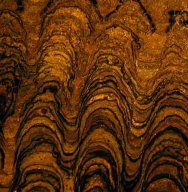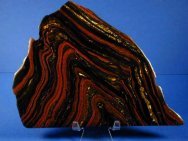about Stromatolites
|
|
Stromatolites, encoding some of the mysteries of Deep TimeIn
many respects stromatolites are the most intriguing fossils
that are our singular visual portal (except for phylogenetic
determination of conserved nucleic acid sequences and molecular
fossils) into deep time on earth, the emergence of life,
and
the eventual evolving of the beautiful life forms from Cambrian
to modern time. A small piece of stromatolite encodes biological
activity perhaps spanning thousands of years. In broad terms,
stromatolites are fossil evidence of the prokaryotic life
that
remains today, as it has always been, the preponderance of
biomass in the biosphere. For those that subscribe to the
theory of
the living earth, it is the prokaryotes that maintain the
homeostasis of the earth, rendering the biosphere habitable
for all other
life. They maintain and recycle the atomic ingredients upon
which proteins that "are" all life are made, including
oxygen, nitrogen and carbon. We humans are, in simple terms,
bags of water filled with proteins and prokaryotic bacteria
(the bacteria in your body outnumber the cells in your body
about 10 to 1). We humans have descended from organisms that
adapted to living in a prokaryotic world, and we humans retain
(conserved in evolutionary terms) in our mitochondria the
cellular
What are stromatolites?Stromatolites
and their close cousins the thrombolites, are rock-like buildups
of microbial
mats that form in limestone- or dolostone-forming environments. Together with
oncoids (formerly called "algal biscuits" or "Girvanella"),
they typically form by the baffling, trapping, and precipitation
of particles
by communities of microorganisms such as bacteria and algae. In some cases,
they can form inorganically, when seawaters are oversaturated
with chemical precipitates.
Stromatolites are defined as laminated accretionary structures that have synoptic
relief (i.e., they stick up above the seafloor). Stromatolite-building
communities
include the oldest known fossils, The only fossils representing 7/8ths of Earth's HistoryExcluding some exceedingly rare Precambrian fossils such as the Ediacaran fauna, stromatolites are the only fossils encoding the first 7/8th of the history of life on earth. They encode the role that ancient microorganisms played in the evolution of life on earth and in shaping earth's environments. The fossil record of stromatolites is astonishingly extensive, spanning 4 billion years of geological history with the forming organisms possibly having occupied every conceivable environment that ever existed. Today, stromatolites are nearly extinct in marine environments, living a precarious existence in only a few localities worldwide. Modern stromatolites were first discovered in Shark Bay, Australia in 1956, and through out western Australia in both marine and non-marine environments. New stromatolite localities have continued to be discovered in various places such as the Bahamas, the Indian Ocean and Yellowstone National Park, to name but a few localities. Stromatolites and the domains of lifeStromatolites are most often described as biogenically-produced structures formed by colonies of photosynthesizing cyanobacteria. However, this is an enormous oversimplification. Science now knows that all domains of life (the Archaeans, Eubacteria, and Eukaryotes) all appeared in the Archaean Era. Which of the prokaryotes came first, the Archaeans or the Eubacteria remains a mystery, but a consensus is emerging that these primitive microorganisms laterally exchanged genes; if so, the concept of the single common ancestor for all life becomes a bit fuzzy (see Woese, 1998). While formation by colonies of cyanobacteria is probably the primary mechanism for formation of stromatolite in the deep time of the Archaean and half way through the Proterozoic, it is unlikely to have been the only mechanism. Recent research indicates the other prokaryotic and the most genetically diverse domain of life, the Archaeans, evolved alongside and possibly swapped genes with the Eubacteria. All prokaryotes (both Eubacteria and the Archaeans reproduce by cell division (binary or multiple fission) and, lacking sex, are essentially clones and among the slowest evolving organisms. Moreover, molecular fossils indicate that primitive Eukaryotic microorganisms appeared more than 3.5 Ba. Thus, before the end of the Archaean time some 2.5 Ba, all three domains of life (Eubacteria, Archaea, and Eukaryotes) existed and were likely already quite diverse. Some were autotrophs, some chemotrophs and some heterotrophs, and collectively they had a multiplicity of metabolic processes from which to derive their energy. Just as microorganisms were extremely diverse in deep time, so is there a corresponding extreme diversity of biogenic and chemical mechanisms that are plausible for the formation of laminar carbonate and other structures that we call stromatolite. Ascribing all stromatolite formation in the Archaean and Proeterozoic to cyanobacteria, seems an unreasonable assumption. When did the prokaryotic organisms that produced stromatolites appear?Other research posits (Bank, C., 2002), based on genome sequencing, that cyanobacteria may have originated as late as 2.3 billion years ago, and were preceded by sulfur-oxidizing bacteria and sulfate-reducing bacteria. This mirrors the changes in the geochemical record, centered around 2.7 billion years ago. The hypothesis is consistent with geology that finds isotopic fractionation of sulfur compounds becomes large, followed by the sudden increase in oxygen in the atmosphere and surface water environments at about 2.2 or 2.3 billion years ago. Whether or not stromatolite contains preserved cellular structure remains controversial, though the consensus is that in special cases, remnants of ancient cell structure can be viewed using special polishing techniques and high magnification. Additionally, determination of atom ratios (so called molecular fossils) in Archaean sediment from Australia has led to sound conjecture that microorganisms with nuclei appeared before 3.8 Ba. The photosynthesizing prokaryotes rusted the oceans and produced the modern atmosphereNonetheless,
the cyanobacteria are conjectured to have been the predominant form of life on
early earth for more than 2 Billion years, and were likely responsible for the
creation of earth's atmospheric oxygen, consuming CO2 and releasing O2 through
their photosynthetic metabolism. Creation of the modern atmosphere is, of course,
perhaps the most critical event in geological history that powered the Cambrian
explosion and subsequent evolution of the aerobic forms of life, including all
animals. During Precambrian times, bacterial mats formed a platform for trapping
and cementation of sediment. For photosynthetic bacteria, depletion of carbon
dioxide in the surrounding water could cause precipitation of calcium carbonate
that along with grains of sediment were then trapped within the sticky layers
of mucilage (that formed a film for UV protection) that surrounding the bacterial
colonies. Cyanobacteria are also capable of directly precipitating calcium carbonate,
with minimal incorporation of sediment within the structure. The bacteria could
repeatedly re-colonize the It is generally accepted that cyanobacteria were the source of oxidants for banded iron-formation. However, recently resolved phylogenetic trees based on whole genomic DNA sequences show that cyanobacteria were one of the last major lineages to diverge off the bacterial tree. This newly resolved tree shows that sulfur-oxidizing bacteria and sulfate-reducing bacteria arose before cyanobacteria did. This mirrors the changes in the geochemical record, centered around 2.7 billion years ago. At this time, the isotopic fractionation of sulfur compounds became large, followed by the sudden increase in oxygen in the atmosphere and surface water environments at about 2.2 or 2.3 billion years ago. Stromatolites are also variously described as being formed by algae that are, in turn, assumed to be plants; this description still persists in old textbooks and on the Internet, but is scientifically incorrect. It is a holdover from a time that cyanobacteria were thought to be algae (and were called blue-green algae) and from when algae were thought to be plants. Actually, cyanobacteria are prokaryotic bacteria (domain of life Eubacteria), and "genomic" science is sill debating whether eukaryotic, photosynthetic, and autotrophic algae are plants or deserve a distinctive phylogenetic grouping. Regardless, the eukaryotic algae did not appear until about 1.5 billion year ago, some two billion years after stromatolites began significantly forming, rusting the seas, and ultimately oxygenated the atmosphere. It is therefore likely that stromatolite formation by algae was not significant until the Phanerozoic, or possibly the Late Proterozoic. While not always recognized as such, Banded Iron Formations (BIFs) are another form of stromatolite. BIFs are massive, laterally extensive and globally distributed chemical sediment deposits that consist primarily of Fe-bearing minerals (iron oxides) and silica. Iron can occur naturally in two states. Reduced, or ferrous iron is soluble in water (water will appear clear at any pH). In the Archaean oceans, prodigious ferrous iron was released from Earth's interior. In the presence of oxygen, however, ferrous iron becomes oxidized to ferric iron and precipitates out as a solid. This is precisely what occured in deep time on a massive scale, as oxygen produced by photosynthetic microorganisms oxidized the ocean's ferrous iron, creating the enormous BIFs we humans mine today. Thus, banded iron layers are the result of oxygen released by photosynthetic organisms combining with dissolved iron in Earth's oceans to form insoluble iron oxides. The banding is assumed to result from cyclicality in oxygen production. It is unclear whether these were seasonal or followed some other cycle. It is assumed that initially the Earth started out with vast amounts of iron dissolved in the world's seas. BIFs in the geologic record date from 3.8 Ga (Isua, West Greenland) to about 1.8 Ga, with a maximal abundance at about 2.5 Ga, and a reoccurrence in Neoproterozoic time (from about 0.8 and 0.6 Ga). The scientific literature commonly attributes the disappearance of BIFs to the fact that deep oceans became oxidized at ~1800 Ma (Cloud, 1972); their formation ostensibly required anoxic deep waters to deliver hydrothermally derived Fe2+ to locations where deposition took place. Konhauser (2002) provides evidence of an alternative mechanism for BIFs by organisms that directly oxidize Fe(II) as an energy source. He argues that the bacterial genera Gallionella and Chromatium use such metabolism and that both are likely to have existed in Precambrian oceans. Interestingly, it is estimated that the amount of oxygen lock-up in earth's BIFs is some 10 times the amount contained in the atmosphere. Stromatolite prevalence and ultimate decline over geologic timeRecent research supports the hypothesis that stromatolite form diversity increased through the Paleoproterozoic, reached a maximum in the Mesaproterozoic at about 1.5 Ba that persisted to about 700 Ma, and steadily declined to several taxa by the Precambrian-Cambrian boundary (Olcott, et. al., and Wray, 1996). This is in contrast to previous data indicating a steep decline at 2 Ba that now appears from the data to be an artifact of 50% of all stromatolite coming from a single basin and author; thus, this decline was in volume. When this regional anomaly is removed, the steepest decline in forms appears to have occurred in the Cambrian. By normalizing stromatolite forms with volume of preserved carbonate rock, the authors posit that the steepest decline in stromatolite form diversity occured in the late Neoproterozoic, and culminated in the Lower Cambrian, coincident with the widespread appearance of macroscopic metazoa and significant bioturbation (i.e., activity of bottom-living animals that keeps sediments oxygenated and homogenous). Conversely, fossil stromatolite indirectly supports the hypothesis that the diversification of major animal phyla occurred between 1 and 1.2 Ba (Wray, 1996). Since laminated sediments are a sign of oxygen depletion in the bottom zone of the sea, bioturbation would inhibit the building of stromatolitic structures. This research seems consistent with evolutionary theory that would anticipate diversification of stromatolite forming taxa due to selective pressure from other organisms that were emerging and themselves diversifying. Modern stromatolites exist in but a few places generally hostile to other lifeWe will likely have no more than a sketchy understanding of the paleoenvironments in which stromatolite was formed in the deep time Precambrian, and only an incomplete understanding of the environments in the Paleozoic. Sound conjecture is possible if we examine the now rare environments that support stromatolitic growth during modern times. Cyanobacteria are found to be a primary organism in the formation of microbial carbonates. These prokaryotic bacteria (slang name is blue-green algae owning to pigmentation involved in photosynthesis) are now only found in areas where there is reduced grazing and burrowing by other organisms, and a low occurrence of macro-algae and plants. Environments where modern stromatolites are found typically are hypersaline, but also include areas of high alkalinity, low nutrients, high or low temperatures, and strong wave or current actions. The obvious pattern emerges that modern stromatolites tend to exist in areas that most other life forms consider less desirable or possibly intolerable. Thus, organisms producing modern stromatolite are generally limited to areas where organisms with which they have to compete and/or organisms that might use them for nutrients are not prevalent. |
|
|
Fossil Mall Navigation: Navigate
by Fossil Category: l Fossils and Paleotological Science Information l | ||||||

 machinery to power our cells that we inherited (i.e., endosymbiosis)
from the prokaryotes of deep time on earth.
machinery to power our cells that we inherited (i.e., endosymbiosis)
from the prokaryotes of deep time on earth. 
